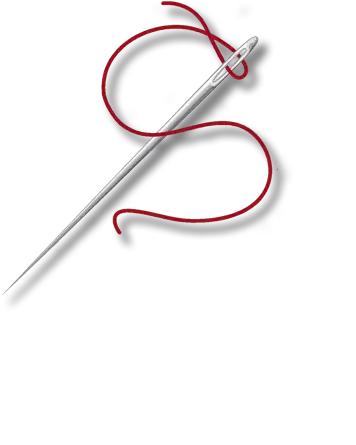The Art of Problem Solving
National Thread the Needle Day, observed on July 25th, is a day dedicated to addressing life's challenges with precision, creativity, and a touch of humor. Much like threading a needle, problem-solving requires focus, patience, and a keen eye for detail. Let's explore the intricacies of this day and how it encourages us to tackle problems head-on with a smile.
The Origins of Threading the Needle
The phrase "threading the needle" is rich in history and has evolved over centuries. Originally rooted in the literal act of sewing, threading a needle requires a steady hand, a keen eye, and considerable patience. The metaphorical use of the phrase likely draws from this precise and delicate task, symbolizing the challenge of navigating through difficult situations or finding a balance between opposing forces.
Interestingly, the phrase has also been linked to various historical contexts beyond sewing. For instance, sailors might have used it to describe navigating a ship through narrow channels or rocky passages, requiring precision and skill similar to the delicate act of threading a needle. This nautical connection highlights the idiom's broader applicability to any scenario requiring meticulous effort and focus.
The phrase has been employed in literature since at least the 16th century, notably in the works of Shakespeare and other contemporary writers. It often described characters successfully maneuvering through complex social or political situations, much like threading a needle through a small eye without snagging.
 Additionally, the phrase appears in ancient texts with slightly different interpretations. For example, in the Bible, the metaphor "It's easier for a camel to pass through the eye of a needle than for a rich man to enter the kingdom of God" underscores the difficulty of achieving seemingly impossible tasks, again reflecting the challenge inherent in threading a needle.
Additionally, the phrase appears in ancient texts with slightly different interpretations. For example, in the Bible, the metaphor "It's easier for a camel to pass through the eye of a needle than for a rich man to enter the kingdom of God" underscores the difficulty of achieving seemingly impossible tasks, again reflecting the challenge inherent in threading a needle.
Over time, "threading the needle" has found its way into various cultural and linguistic contexts worldwide, often adapted to fit local idiomatic expressions while retaining its core meaning of achieving difficult feats with precision and care.
The Problem-Solving Process
-
Identify the Problem: The first step is recognizing that a problem exists. This might seem obvious, but sometimes, the real issue can be hidden beneath layers of symptoms. Imagine trying to find a needle in a haystack—knowing that the needle is in there somewhere is the first step.
-
Break It Down: Large problems can be overwhelming. Breaking them into smaller, manageable parts makes them less intimidating. Think of it as unraveling a tangled ball of yarn; you tackle it one knot at a time.
-
Brainstorm Solutions: This is where creativity comes into play. There are often multiple ways to solve a problem, and brainstorming allows you to explore different angles. Imagine a brainstorming session as a lively debate between cheeses and wines trying to find their perfect pairing.
-
Evaluate and Choose: Weigh the pros and cons of each potential solution. It’s like choosing the best cheese for your wine party—you consider texture, flavor, and aroma to make the best choice.
-
Implement the Solution: Once you’ve chosen the best course of action, it’s time to put it into practice. This step is akin to actually threading the needle—steady your hands and focus on getting the thread through the eye.
-
Review and Reflect: After implementing the solution, it’s crucial to review the outcome. Did it solve the problem? What could be improved next time? This reflective step ensures continuous improvement.
Imagine problem-solving as a reality TV show where everyday challenges are presented to contestants. The host, a suave and slightly mischievous character, presents a problem like a tangled necklace or a stubborn jar lid that won’t open. Contestants are given a toolkit that includes duct tape, a rubber chicken, and a motivational cat poster. The audience watches in amusement as contestants use creativity and resourcefulness to solve the problems, often with hilarious results.
For instance, when faced with the tangled necklace, one contestant might decide to bribe the necklace with a piece of cheese. Another might use the rubber chicken as a makeshift lever to open the jar lid. Meanwhile, the motivational cat poster provides moral support, reminding everyone to "Hang in there!"
Real-Life Application
In real life, problem-solving might not involve rubber chickens, but it does benefit from creativity and humor. When you’re stuck on a difficult task at work or dealing with a tricky situation at home, injecting a bit of humor can lighten the mood and open your mind to new solutions. Laughter reduces stress and fosters a positive environment, making it easier to think clearly and approach problems from different angles.
National Thread the Needle Day reminds us that with a bit of focus, creativity, and humor, we can navigate life’s challenges more effectively. Whether you’re untangling a necklace, threading a literal needle, or solving a complex problem at work, remember to keep a steady hand and an open mind. And if all else fails, a motivational cat poster never hurts! So, on July 25th, let’s celebrate the art of problem-solving with a smile and perhaps a bit of cheese.
Please Share our Content






 Additionally, the phrase appears in ancient texts with slightly different interpretations. For example, in the Bible, the metaphor "It's easier for a camel to pass through the eye of a needle than for a rich man to enter the kingdom of God" underscores the difficulty of achieving seemingly impossible tasks, again reflecting the challenge inherent in threading a needle.
Additionally, the phrase appears in ancient texts with slightly different interpretations. For example, in the Bible, the metaphor "It's easier for a camel to pass through the eye of a needle than for a rich man to enter the kingdom of God" underscores the difficulty of achieving seemingly impossible tasks, again reflecting the challenge inherent in threading a needle.








 "Sláinte!" is a traditional Irish expression used as a toast, equivalent to "Cheers!" in English.
"Sláinte!" is a traditional Irish expression used as a toast, equivalent to "Cheers!" in English.